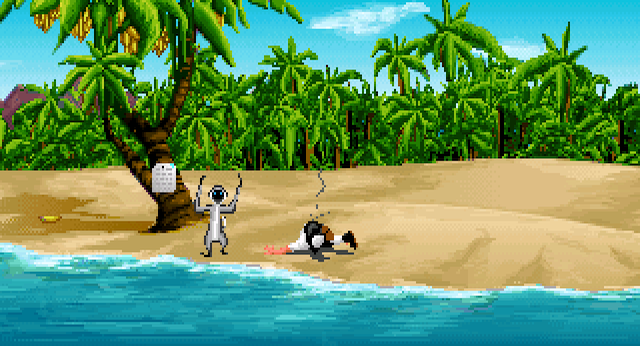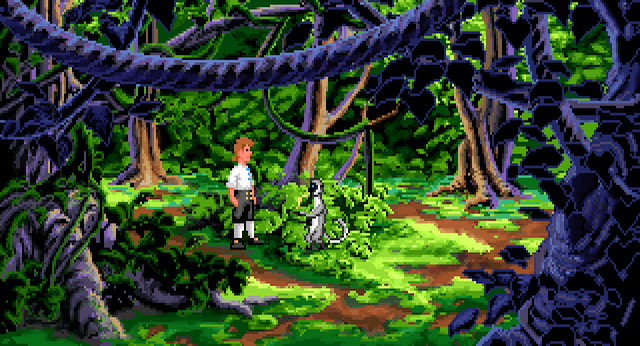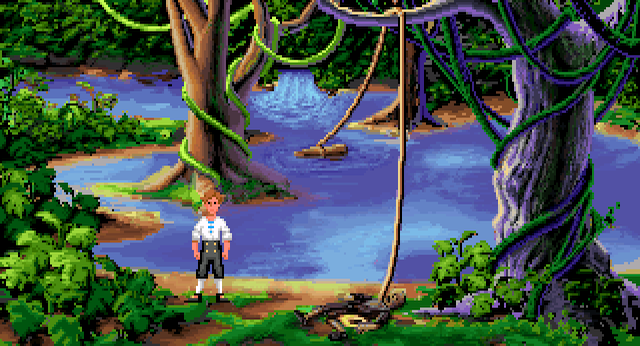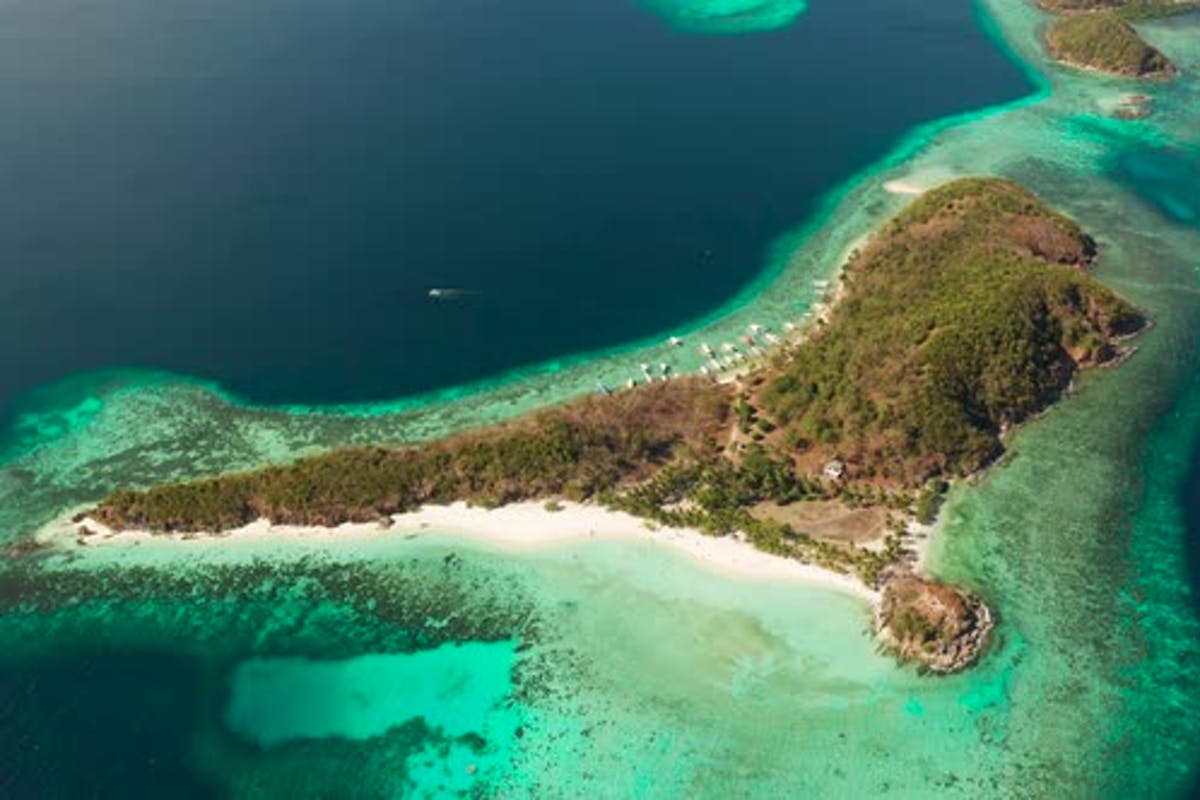4: A Profusion of Banana Trees
I am not a botanist, but:
Ceci n’est pas un banana tree
[Note to self: only do »funny« plays on words in titles when they actually are funny]
If you are as fed up with water as I am, let’s continue to what most beings on this planet use water for: to grow living stuff.
We have seen this before:

That plant in the left middle ground, next to the dancing monkey and with a memo tagged to it, and from which it looks a banana fell down, and where banana bunches hang [upside down and without flower stem?] below its fronds, is a banana tree. (You probably remember the puzzle where you accidentally destroy your ship [the Sea Monkey] by dropping off a boulder from the island’s top, while you actually try to hit this tree to make it drop more bananas to give them to a monkey to follow you around and – in good conquistador fashion – force it into slave labor and work for you by dangling from a totem’s »nose«. [That’s a quite linear Puzzle Dependency Chart.])
All the trees in the background seem to look very, very similar to the banana tree in the foreground. Sure, Caribbean, banana trees. No? Ah, interesting fact!:
According to The Other Wiki, »Almost all modern edible seedless (parthenocarp) bananas come from two wild species – Musa acuminata and Musa balbisiana.« But »Musa species are native to tropical Indomalaya and Australia, and are likely to have been first domesticated in Papua New Guinea.« And last but not least: »In the 15th and 16th centuries, Portuguese colonists started banana plantations in the Atlantic Islands, Brazil, and western Africa.« [1]
TL;DR Banana trees are not native to the Caribbean! But that’s not really a problem: the Cannibals could have introduced them (there are enough instances in history where native/ancient events were not recognized by Western scholars) as could have Herman Toothrot. And there are multiple known cases of plagues of invading, foreign species that might lead to a profusion of banana trees on this island. (And anyways, it’s inspired by a Disneyland ride, for Bob’s sake, and they are not exactly known for their historical accuracy.)
Anyways, my first stop is to plant banana trees on my island, because a) they are canon and b) it’s at least a start. No? If you want to see how a completely banana tree-populated »jungle« looks like, see this screenshot:

Almost obviously, walking through that is boring. (But if you like the banana trees, which I consider more stylized than photorealistic, and which come with wind animation and interaction, it’s this asset here.)
There are a few dead banana leaves, but no other ground vegetation, no other types of larger plants, no other types of trees, and none of the famous multi-storey layout a jungle is supposed to have. But that’s just my rough draft.
Luckily, there are other plants around:


I am unable to identify any of them. In the bottom image on the lower left might be monstera, which – rejoice! – is native to the Americas. Note the huge part of green ground cover, though.
I did spend two weeks quite deep in the Bolivian jungle, which I don’t assume to be identical to Caribbean rainforest, but at least comparable. [Yes, I remember a father figure once telling me that »assume« would make an »ass« of »u« and »me«.] There I saw that the ground – like in other forests I have seen – is indeed brown, not green. It’s covered in dead leaves and plant parts. It’s only green when there is actively living plant life on it. But that doesn’t match our expectation of it! Every jungle movie Dwayne Johnson has recently done avoids for the most part to show the ground, but only the green stuff, but our first-person player character does not look from a fancy camera position, but from bland eye-height.
Coming back to my – very late – idea of concerning myself a bit more with the experience of walking that island instead of its map, I should look more at reference! Not only in-game, but also real-world:
Plants, Landscape Material and Foliage Auto-Population
This below is an aerial shot of a very small Caribbean island. Note the water shallows, the beach color, the hill profiles, the type and distribution of vegetation and rocks:

I am using Zak »Unreal Sensei« Hunter’s Auto-Landscape Material, and for the ground material I picked one of Quixel Megascans’ »Jungle Ground«. As I populate the Landscape Grass Types (because they will auto-populate the landscape material) with the banana tree assets, it becomes obvious that I will have a performance issue: in the jungle you can’t see that far, so draw distance for the »grass« is reasonable. But unfortunately, due to the concave island shore, I will be able to see quite far from parts of the shore, too, and when I’m up at the boulder-dropping vista, I’ll be able to see the whole island!
With a density of banana trees I am comfortable with (see screenshots), this gets my GTX 1080 to about 15 fps.
At this point, so much has appeared as obstacles that I decide to drop or put this project on hold indefinitely: the scale seems wrong, I don’t get the the Water System to work as planned, I have no ideas about optimization, and I am still unsatisfied with my shore dropoffs. And – last, but probably first for a potential player – it seems that it will be boring to play.
In defiance of the Sunk Cost Fallacy, I decide to say goodbye to Monkey Island™ for now, but I do have learned a couple of things. And, knowing myself, maybe I’ll be back another time and start afresh.
Get Study: Island of Monkeys terrain (v1)
Study: Island of Monkeys terrain (v1)
De- and reconstructing a certain (probably trademarked) island, deep in the Caribbean
| Status | Prototype |
| Category | Assets |
| Author | Cinewulf |
| Tags | 3D, Casual, Exploration, Fangame, First-Person, heightmap, landscape, monkey-island, Singleplayer, Walking simulator |
| Accessibility | Textless |
More posts
- Conclusion: How Not To Create A Playable MapFeb 13, 2022
- 3: The Rivers Run Dry – landscape and waterFeb 01, 2022
- 2: Eroding To A Target – terrain creationJan 27, 2022
- 1: No X Marks Any Spot – the base mapJan 23, 2022

Leave a comment
Log in with itch.io to leave a comment.